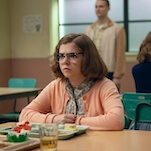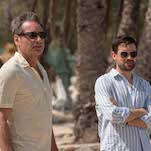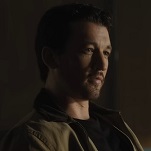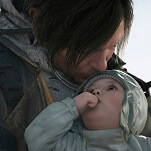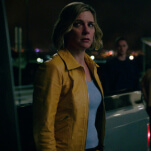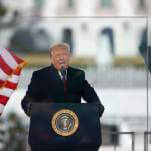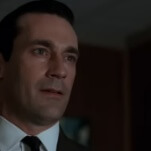Outlast 2 Garishly Exploits Your Sexual Hangups For Horror
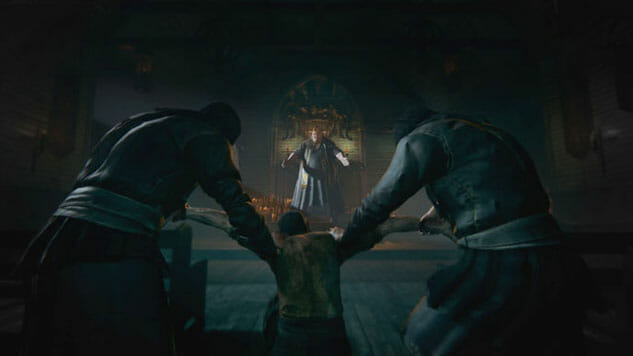
Spoiler warning: this article discusses major plot points from the game.
Somewhere deep within a mountain canyon in rural Arizona, Outlast 2’s Blake Langermann runs through dust and darkness pursued by a Christian fanatic. Looking through his eyes, the player hops wooden fences and scans through the electric green static of a handheld camcorder’s night-vision for a rain barrel or rotted wooden closet she can tuck the terrified journalist inside. A moment of hesitation spent trying to decide whether to sprint further or hide and time runs out. The Christian grabs Blake, beating him about the head until he slumps to the ground. The last thing we see is a knife jammed into Blake’s crotch to the accompaniment of lustful grunts and panicked screams.
Searching desperately for his fellow journalist and wife Lynn, lost after a helicopter crash stranded the couple in the canyons, Blake finds himself caught up in the grand eschatological designs of two opposing groups: the homicidally zealous citizens of Temple Gate who worship self-proclaimed prophet Sullivan Knoth and a sect of hazily defined Satan-worshipers lead by a heretical exile named Val. Both groups are determined to abduct Lynn. She’s unexpectedly pregnant and is due to give birth at any moment, though this comes as a surprise to Blake and player both. (Lynn doesn’t look like she’s nine months along until the next time she’s seen up close during the game’s finale.) Knoth and Val’s followers are both trying to kidnap Lynn because they believe she’s carrying the Anti-Christ. The Christians want the child killed immediately to ward off the False Messiah’s evil; the others want it kept safe to ensure the opposite. Neither group sees Lynn as anything more than a decisive piece in a grand cosmic game.
On its surface, the obsessive Christians of Outlast 2 seem like a condemnation of religion. Amid the upfront creepiness of the fanatics who kidnapped Lynn, this theme is continued through flashbacks to Blake’s days in a Catholic high school when he failed to save a classmate from being sexually abused by a priest. Her subsequent death haunts him. In the present day and nightmarish memory, Blake is surrounded by crosses. They line the walls of classrooms and hallways in flashback; they dot graveyards, top houses and occupy spots of importance in Temple Gates’ many houses and community buildings. Alongside the human viscera and buckets of blood covering most every surface of the game’s environments, the crosses leave the game’s strongest visual impression.
The constant association of gore with Christianity’s chief symbol is overdone (it’s hard to walk five steps without finding some combination of severed body part and cross), but it’s also key to Outlast 2’s preoccupation with the religion’s violent underpinnings. It’s a game that quite rightly wishes to criticize the bloody foundation of a major system of faith, splattering the cross as a reminder of the torturous death it represents and evoking murderous extremists as a blown out, entirely unsubtle stand-in for the hate and horror so often carried out in the name of a loving God.
To that extent, Outlast 2 is a moderate success— even as it conveys its message with the nuance of a teenager, certain they’re the first and only person in human history hip to religious hypocrisy. It’s symbolism, though, is rich enough to be worthwhile. In the town of Temple Gate and the figure of Knoth, who refers to himself as “the Modern Ezekiel”, the game implies a twisted version of Old Testament prophecies regarding the building of the Third Temple. The Biblical Ezekiel was given visions of the destruction of Jerusalem and an eventual return to the city, construction of the Third Temple and the beginning of the Messianic Age—simply put, necessary preparations for Satan’s final defeat and the establishment of the Kingdom of God. Knoth, too, believes he has been graced with divine foresight. His obsession with individual responsibility for sin, the need to strictly adhere to God’s laws and a willingness to sacrifice in order to “purify” his community are echoes of Abrahamic eschatological thought, nuance hammered away into a bizarre, frightening new shape.
Outlast 2 sees Ezekiel’s prophecies enacted in summary. Knoth, like the Biblical figure, believes God speaks to him and prepares his people accordingly. He enforces a self-serving version of God’s law that allows him to sleep with the women of Temple Gate, control his congregants’ sexual behaviour and most frighteningly, kill newborns if he believes they may be the Anti-Christ. As the game progresses, Blake sees the dead rise again in visions like the prophecy of the valley of bones. He sees Temple Gate’s enemies (Val and her Satanist heretics) destroyed in a mass slaughter near the game’s climax. He sees plague visit their home just like Ezekiel’s vision of the defeat of Gog and Magog, enemies of Israel and allies of Satan.
The recurring, blinding flashes of light throughout the game and the radio tower looming above the canyons are implied to be signals urging the people of Temple Gate into the hallucinations responsible for Knoth’s prophetic visions (and the citizen’s eagerness to murder in the name of Jesus or Satan). The signal comes with an explosion of brightness and a bowel-loosening horn blast that resembles the Voice of God. The suggestion is that, just below a socially acceptable surface, the Christians of Temple Gate are looming extremists, ready to murder, rape and war with one another according to their beliefs when loosed from the confines of modern American culture.



